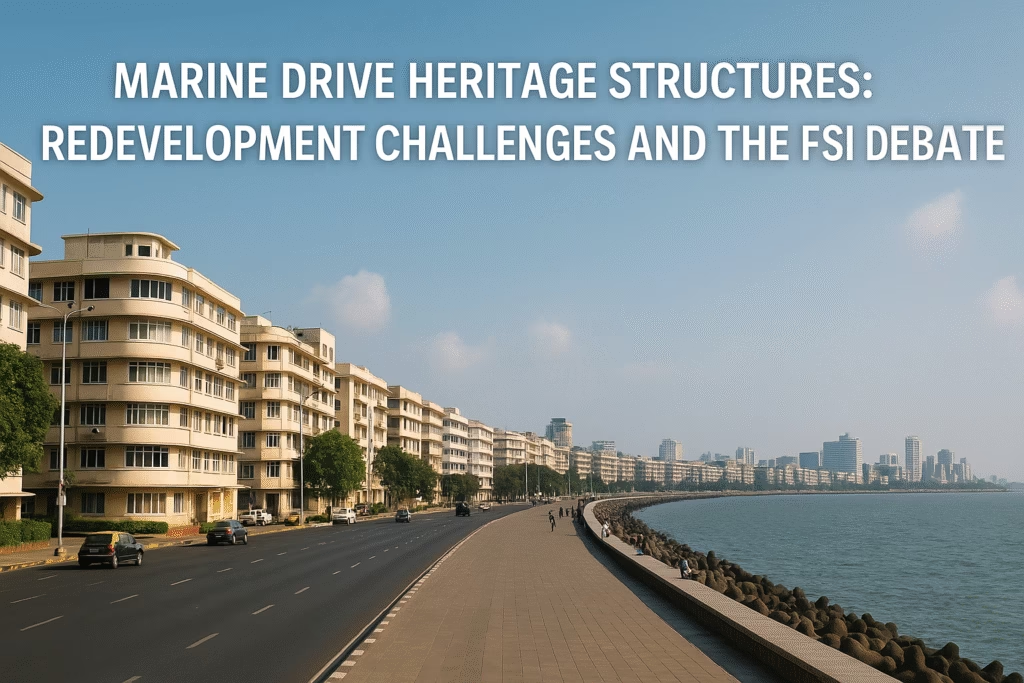
Marine Drive Heritage Structures: Redevelopment Challenges and the FSI Debate
Marine Drive, often referred to as the “Queen’s Necklace” of Mumbai, is not just a scenic promenade but a vital part of the city’s Art Deco heritage. This crescent-shaped boulevard along the Arabian Sea is home to over 30 heritage-listed buildings, many of which contribute to Mumbai’s status as a UNESCO World Heritage Site for its Art Deco architecture. As redevelopment plans gain momentum across the city, Marine Drive finds itself at the center of a complex debate involving heritage preservation, urban growth, and Floor Space Index (FSI) policies.
Heritage Status of Marine Drive
The buildings lining Marine Drive are protected under the Heritage Regulations of Greater Mumbai 1995. They are primarily Grade II and Grade III heritage structures, meaning they are recognized for their architectural and historical value. These regulations restrict structural changes, ensuring that redevelopment must preserve the façade, character, and skyline of the area.
Impact of Redevelopment Plans
While other parts of Mumbai are witnessing vertical growth thanks to increased FSI and redevelopment incentives, Marine Drive remains largely untouched due to its stringent heritage restrictions. Builders and developers face challenges such as:
- Limited vertical expansion due to low permissible FSI in heritage zones.
- Mandatory approvals from the Mumbai Heritage Conservation Committee (MHCC).
- High costs of restoring old structures to comply with modern standards without altering their heritage aspects.
As a result, many aging buildings remain underutilized, facing structural wear without financial viability for redevelopment under current rules.
The FSI Conundrum
FSI (Floor Space Index) plays a crucial role in determining how much can be built on a given plot of land. In Marine Drive’s heritage precinct, the FSI is typically capped at 1.33, compared to areas with 2.5–5.0 in newer zones of Mumbai. This cap protects the uniform Art Deco skyline but limits the economic incentive for redevelopment.
Debates around increasing FSI in such areas are met with mixed reactions:
- Heritage advocates argue that higher FSI will destroy the visual and cultural integrity of Marine Drive.
- Urban planners and developers call for flexible norms that allow for sustainability, safety upgrades, and economic viability without compromising aesthetics.
Preservation vs. Progress: Finding Middle Ground
The key challenge is to balance redevelopment with conservation. Some experts propose solutions such as:
- Incentivizing restoration by offering Transferable Development Rights (TDR) in non-heritage zones.
- Allowing adaptive reuse of buildings—such as converting old apartments into boutique hotels or commercial spaces.
- Implementing stringent architectural guidelines for any redevelopment to retain the Art Deco charm.
Conclusion
Marine Drive represents more than real estate—it’s a symbol of Mumbai’s cosmopolitan history and architectural legacy. Any changes in redevelopment policies or FSI regulations must tread carefully to ensure that modernization doesn’t come at the cost of identity. The road ahead requires inclusive dialogue between heritage bodies, residents, urban planners, and developers to create a future that respects the past while embracing the needs of tomorrow.
